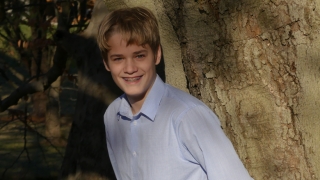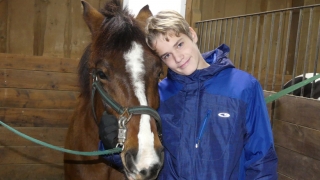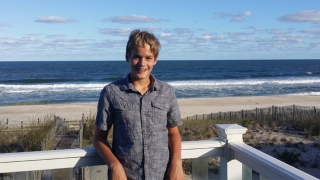Sand Drowning: Edgar’s ECMO Story
Published on
Published on
It was every parent’s worst nightmare. Jaime and Angela Ryan and two of their sons had left the beach to take their dog for a quick walk. Their 12-year-old son, Edgar, remained behind, playing in the sand. The Ryans were just half a block away when they heard the sirens. Jaime ran back to the beach and saw a group of emergency personnel working to save a child.
It was his son.
 In the next few minutes, as the first responders worked to stabilize Edgar, Jaime and Angela frantically tried to piece together what had happened. A police officer told them that the sand cave Edgar had been building had collapsed while he was inside it. His heart had stopped, and he couldn’t breathe. Beachgoers and lifeguards acted quickly and started bystander cardiopulmonary resuscitation as the other first responders arrived. Recognizing the seriousness of the situation, the town called for a medevac.
In the next few minutes, as the first responders worked to stabilize Edgar, Jaime and Angela frantically tried to piece together what had happened. A police officer told them that the sand cave Edgar had been building had collapsed while he was inside it. His heart had stopped, and he couldn’t breathe. Beachgoers and lifeguards acted quickly and started bystander cardiopulmonary resuscitation as the other first responders arrived. Recognizing the seriousness of the situation, the town called for a medevac.
A helicopter arrived to take Edgar to Cooper University Hospital in Camden, NJ. “I’m not normally a person who prays, but in situations like this, you grasp for anything that you can come up with,” says Angela. “Whatever you can think of, we were doing.”
At Cooper, a team worked on Edgar for a few hours, but could not stabilize him: His lungs were full of wet sand — a condition called “sand drowning.” The team explained to the Ryans that their son’s situation was dire, and recommended that Edgar be transferred to a facility that offered extracorporeal membrane oxygenation (ECMO), a highly specialized treatment performed using a small, portable heart-lung bypass machine, to survive.
At 10:30 p.m., an ambulance rushed Angela and Edgar to Children’s Hospital of Philadelphia (CHOP). Jaime followed by car.
When he arrived at CHOP, Edgar was taken to the Pediatric Intensive Care Unit (PICU), and his parents met with Todd Kilbaugh, MD, Director of the ECMO Center at CHOP, and other members of the team that would be caring for their son. The team was set up and ready to place Edgar on ECMO as soon as he arrived.
Placing a child “on ECMO” is a complex and difficult procedure, but the Ryans knew Edgar was in the very best hands — CHOP’s ECMO team is one of the most experienced in the world, and has treated more than 1,160 patients. During the procedure, the ECMO team placed plastic tubes called cannulas in the veins in Edgar’s neck. The tubes would circulate Edgar’s blood to the “ECMO lung,” which does the work of a healthy lung: oxygenating the blood and removing carbon dioxide. The team explained to the Ryans that the ECMO machine would allow Edgar’s lungs to rest so that doctors could clean his lungs and remove the sand he had inhaled. Edgar was also placed on a special ventilator that provided additional support for his lungs.
Edgar remained on ECMO, heavily sedated, for the next two weeks.
 Expert care from an experienced team
Expert care from an experienced teamWhile Edgar was on ECMO, he was carefully monitored by CHOP’s world-renowned ECMO team, which includes pediatric surgeons, intensivists, perfusionists, nurses and respiratory therapists. A specially trained nurse and an ECMO specialist were at Edgar’s bedside at all times, and Dr. Kilbaugh performed bronchoscopies daily to remove the sand from his lungs. The team also replaced the liquid in Edgar’s lungs, called surfactant, with a synthetic surfactant, and physical therapists used special techniques to help him maintain muscle mass and strength to speed his recovery.
“We were really fortunate to have the greatest team in the world,” says Jaime.
Edgar was taken off the ECMO machine once his lungs recovered, and shortly thereafter he was able to breathe on his own with the aid of a ventilator. Specialists from across CHOP were there to support Edgar as he continued to heal. The Hospital’s child life specialists and pet therapy dogs also visited often.
“They were such a light in his day,” says Angela. “The nurse told us that after the dogs had been there, he was a different kid.”
In late October, three months after he arrived at CHOP, Edgar was moved to the Hospital’s rehabilitation facility, Children’s Seashore House, where he received physical and occupational therapy. Because of the excellent care Edgar had received from the physical, occupational and speech therapy specialists while he was in the PICU, he was able to go home a few days later. Edgar continued with outpatient physical therapy at CHOP to complete his recovery.
 Today, a year and a half after the accident that nearly took his life, Edgar is a perfectly healthy high school freshman. He loves horseback riding and robotics, and he’s even started surfing again.
Today, a year and a half after the accident that nearly took his life, Edgar is a perfectly healthy high school freshman. He loves horseback riding and robotics, and he’s even started surfing again.
“There are no physical signs that anything happened to him,” Angela says. “He’s back to baseline in every possible way.”
Edgar was one of the lucky ones: Most children who experience sand drowning do not survive.
To show their gratitude to Children’s Hospital, the Ryans have established the Edgar Ryan ECMO Research Fund, which will provide funding for Dr. Kilbaugh’s research and help advance the technology that saved their son.
“We’re incredibly thankful,” says Jaime. “It’s because of the staff and the technology available at CHOP that he’s with us today.”
Originally published January 2017